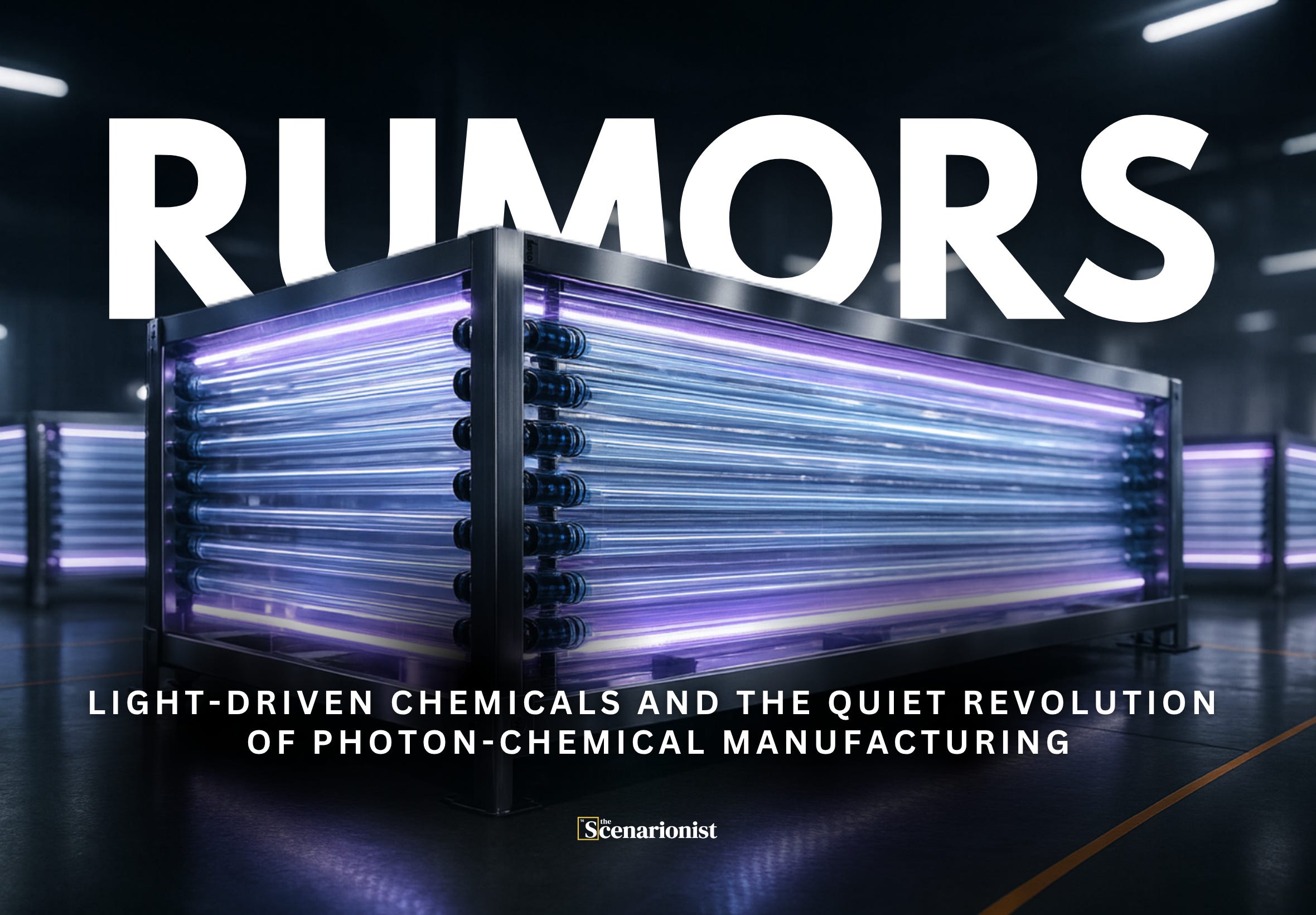Light-Driven Chemicals and the Quiet Revolution of Photon-Chemical Manufacturing | Rumors
Five Startups, One Rumor: New light‑powered reactions aid energy use, efficiency, feedstock risk, and margins in chemical manufacturing.
Welcome to Rumors.
✨ Rumors is a pattern-recognition layer for investors, founders, and operators who care about where the frontier is heading—before it becomes consensus, before the rest of the market connects the dots.
Discover. Compare. Assess. Stay ahead.
1. From Fossil Heat to Photons: Rewriting the Process Baseline
Modern chemical manufacturing is placing unprecedented demands on energy systems, feedstocks, and carbon budgets.
The chemical sector is now the largest industrial energy consumer and the third-largest source of direct industrial CO2 emissions, according to the International Energy Agency [1]. When you fold in both fuel and feedstock use, chemicals and petrochemicals account for roughly 10 % of global final energy consumption and around 7 % of industry-related greenhouse-gas emissions—a share that is still rising as demand for plastics, fertilizers, coatings and specialty intermediates grows. Analyses of industrial energy use [2] and sector-level emissions breakdowns [3] converge on the same picture: a massive base of long-lived assets whose business model is built on high-temperature heat from fossil fuels and fossil-derived carbon as feedstock.
The result is a situation where product volumes keep climbing while the sector’s operating space tightens. Energy-intensive processes and steam crackers were tolerable when fuels were cheap and carbon was free; they look less comfortable in a world where energy-related CO2 emissions just hit a record 37.8 Gt [4] and industrial emitters are expected to shoulder a disproportionate share of future reductions.
At the same time, producers face feedstock risk as oil and gas markets swing, regulatory pressure from emerging carbon border mechanisms and sectoral roadmaps, and customer pressure as downstream brands commit to “low-carbon” and “bio-based” materials.
Recent work on well-to-gate emissions from petrochemicals [5] and global GHG breakdowns by sector [6] suggests chemicals and petrochemicals alone contribute on the order of 5–6 % of global GHG emissions—putting the sector in the same league as steel and cement.
Given this pressure, a new class of technologies is entering the conversation: light-driven, or photon-chemical, manufacturing. Instead of driving key steps with only heat and pressure, these approaches use photons as a first-class energy input, often at or near ambient temperature.
Visible-light photoredox catalysis [7] and related photocatalytic methods can mediate redox steps with LEDs rather than burners, while continuous-flow photochemistry [8] and modern reactor designs [9] solve old problems of light penetration, heat management and scale-up that kept photochemistry in the “lab curiosity” box for decades.
In parallel, hybrid photo-thermal reactors combine concentrated sunlight with catalysts to turn CO₂ and green H₂ into synthesis gas and liquid fuels, while emerging photochemical routes promise to valorize lignin into aromatics instead of burning it [10], and to generate hazardous intermediates like phosgene in situ under light rather than storing them in bulk.
Large incumbents are taking notice. Pharma and specialty producers have already brought flow photochemical steps into GMP manufacturing [11] ; academic labs continue to publish high-productivity flow photoreactors [12] and metallaphotoredox scale-ups [13] ; and early industrial pilots are exploring solar-driven CO₂-to-fuel plants and “photo-on-demand” phosgenation in modular units.
A new cohort of startups is racing to productise this emerging toolkit: LED-driven photocatalysis platforms for fine chemicals, solar reactors for CO₂-derived fuels, modular photo-flow hardware for plants that want to “plug in” light, lignin-to-aromatics processes, and light-driven micro-plants for hazardous intermediates. Venture and corporate capital is following, treating photons + catalysts + flow hardware as a new infrastructure layer in chemical manufacturing rather than a niche lab technique.
✨ This Rumor investigates why photon-chemical manufacturing is emerging now, what macro forces drive adoption, which problems it hopes to solve, and where the leading players are focusing.
At its core is a map of five startups across the US, Europe, and Japan — each attacking a different choke point in the photon-chemical stack: cleaner commodity routes, solar fuels, photochemical tooling, lignin-to-aromatics, and on-demand hazardous intermediates.
It analyzes market metrics, compares the approaches of these platforms, examines competitive dynamics, follows where capital is flowing, and offers a strategic lens on how these shifts affect chemical majors, utilities, engineering firms, and the broader industrial ecosystem.
It also considers risks and limitations, then looks ahead to how plants, assets, and supply chains might evolve over the next decade if light becomes a standard knob in the chemical process toolbox.
✨ Before You Dive In:
Rumors is just one part of The Scenarionist experience. To enjoy the full experience, become a Premium Member!
2. Macro Frame: Why Now?
Photochemical processing is not a new idea; industrial plants have used UV-driven chlorinations, polymerizations and curing steps for decades in coatings, inks and plastics, as documented in early industrial photochemistry surveys.
Historically, though, the core of chemical manufacturing stayed with high-temperature, fossil-fuelled reactors because early UV systems were lamp-limited, hard to scale uniformly and awkward to integrate into continuous plants built around steam and burners.
Five converging forces are changing that calculus:


